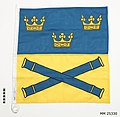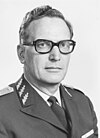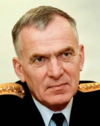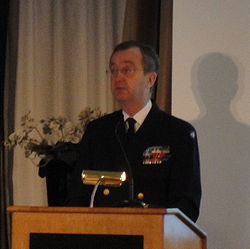Chief of Defence (Sweden)
Highest-ranking professional military officer in the Swedish Armed Forces From Wikipedia, the free encyclopedia
The Chief of Defence, formerly the Supreme Commander of the Swedish Armed Forces[b] (Swedish: överbefälhavaren; acronym: ÖB) is the highest ranked professional military officer in the Swedish Armed Forces, and is by NATO terminology the Swedish chief of defence equivalent. The Chief of Defence is the agency head of the Swedish Armed Forces and formally reports to the Government of Sweden, though normally through the Minister for Defence.[5][c] The primary responsibilities and duties of the Chief of Defence (and the charter for the Armed Forces) are prescribed in an ordinance issued by the Government.[6]
| Chief of Defence of the Swedish Armed Forces | |
|---|---|
| Överbefälhavaren | |
 Command flag of the Chief of Defence | |
| Swedish Armed Forces | |
| Reports to | The Government (in practice through the Minister for Defence) |
| Residence | Karlberg Palace |
| Seat | Lidingövägen 24, Stockholm, Sweden |
| Nominator | Minister for Defence |
| Appointer | The Government |
| Constituting instrument | Förordning (2007:1266) med instruktion för Försvarsmakten (current ordinance) |
| Precursor | None[a] |
| Formation | 8 December 1939 |
| First holder | Olof Thörnell |
| Deputy | Director General of the Swedish Armed Forces |
| Website | Official website |
The Chief of Defence is, apart from the honorary ranks held by the King of Sweden and in the past other members of the Swedish royal family, by unwritten convention normally the only professional military officer on active duty to hold the highest rank (a four-star General or Admiral).[7] An exception was made 2009-2014 when Håkan Syrén was chairman of the European Union Military Committee.
The present Chief of Defence, General Michael Claesson, took office on 1 October 2024.
History
Before the modern era, the King was expected to command the forces himself; not seldom on location during war campaigns as shown by Gustavus Adolphus, Charles X, Charles XI, Charles XII and Gustav III. This remained the case formally until the 20th century. From the late 19th century onwards, there were no service chiefs of the Army or Navy; all senior service commanders reported directly to the King in Council. Apart from a single Minister for Defence created in 1919 by merging the position of ministers of the land forces and naval forces, no joint command structure existed.[7]
In 1936, a Supreme Commander was intended to be appointed in war-time-only, and on 1 December 1939, during World War II, the first Supreme Commander, General Olof Thörnell, was appointed.[7] In 1942 it was decided to keep this office even after the end of the war. The Supreme Commander would in wartime formally report to the King in Council until the enactment of the new Instrument of Government in 1974, and after 1 January 1975 to the Government.[7]
Heraldry
The coat of arms of the Chief of Defence was used from 1991 to 1993. It has since 1993 been used by the Swedish Armed Forces and was used from 1994 to 2001 by the Swedish Armed Forces Headquarters. Blazon: "Azure, lesser coat of arms of Sweden, three open crowns or placed two and one. The shield surmounting an erect sword of the last colour".[8]
- Coat of arms of the Chief of Defence used 1991 to 1993.
The command flag of the Chief of Defence is drawn by Brita Grep and embroidered by hand by the Kedja studio, Heraldica. Blazon: "Fessed in blue and yellow; on blue three open yellow crowns placed two and one, on yellow two blue batons of command with sets of open yellow crowns placed two and one in saltire."[9]
- Command flag of the Chief of Defence.
- Command sign of the Chief of Defence.
List of Chiefs of Defence
Summarize
Perspective
| No. | Portrait | Name | Took office | Left office | Time in office | Defence branch | Prime Minister | Ref. |
|---|---|---|---|---|---|---|---|---|
| Supreme Commander (1937–2024) | ||||||||
| 1 | General Olof Thörnell RoKKMO, KmstkSO, RVO (1877–1977) | 8 December 1939 | 31 March 1944 | 4 years, 114 days |  Army | Per Albin Hansson | [7] | |
| 2 | General Helge Jung RoKKMO, KmstkSO, RVO1kl, RNO (1886–1978) | 1 April 1944 | 31 March 1951 | 6 years, 364 days |  Army | Per Albin Hansson Tage Erlander | [7] | |
| 3 | General Nils Swedlund RoKKMO, KmstkSO, KNO2kl, RVO (1898–1965) | 1 April 1951[d] | 30 September 1961 | 10 years, 182 days |  Army | Tage Erlander | [10] | |
| 4 | General Torsten Rapp RoKKMO, KmstkSO, RNO, RVO (1905–1993) | 1 October 1961 | 30 September 1970 | 8 years, 364 days |  Air Force | Tage Erlander Olof Palme | [7] | |
| 5 | General Stig Synnergren KmstkSO (1915–2004) | 1 October 1970 | 30 September 1978 | 7 years, 364 days |  Army | Olof Palme Thorbjörn Fälldin | [7] | |
| 6 | General Lennart Ljung KSO1kl (1921–1990) | 1 October 1978 | 30 September 1986 | 7 years, 364 days |  Army | Thorbjörn Fälldin Ola Ullsten Olof Palme Ingvar Carlsson | [7] | |
| 7 | General Bengt Gustafsson (1933–2019) | 1 October 1986 | 30 June 1994 | 7 years, 272 days |  Army | Ingvar Carlsson Carl Bildt | [7] | |
| 8 | General Owe Wiktorin (born 1940) | 1 July 1994 | 30 June 2000 | 5 years, 365 days |  Air Force | Carl Bildt Ingvar Carlsson Göran Persson | [7][11] | |
| 9 | General Johan Hederstedt (born 1943) | 1 July 2000 | 31 December 2003 | 3 years, 184 days |  Army | Göran Persson | [7][12] | |
| 10 | General Håkan Syrén (born 1952) | 1 January 2004 | 24 March 2009 | 5 years, 82 days |  Navy (Amphibious Corps) | Göran Persson Fredrik Reinfeldt | [7] | |
| 11 | General Sverker Göranson (born 1954) | 25 March 2009 | 30 September 2015 | 6 years, 189 days |  Army | Fredrik Reinfeldt Stefan Löfven | [13] | |
| 12 | General Micael Bydén (born 1964) | 1 October 2015 | 30 September 2024 | 8 years, 365 days |  Air Force | Stefan Löfven Magdalena Andersson Ulf Kristersson | [14] | |
| Chiefs of Defence (2024–present) | ||||||||
| 13 | General Michael Claesson (born 1965) | 1 October 2024 | Incumbent | 184 days |  Army | Ulf Kristersson | [15] | |
Timeline

Every time a new Chief of Defence is to be appointed, there is some debate between the different services. Some feel that some kind of rotational system would be appropriate. In actuality, most Chiefs of Defence have come from the Army, and only one, Håkan Syrén, from the Navy. Because he is a general of the Amphibious Corps, there has to this day not been a single admiral to hold the office.
List of Deputy Supreme Commanders
Summarize
Perspective
Until 30 June 1994, the Chief of the Defence Staff was the second most senior member of the Swedish Armed Forces. When the Swedish Armed Forces was reorganized on 1 July 1994, the Chief of the Defence Staff position was abolished. Lieutenant General Percurt Green became the first Deputy Chief of Defence who took office on 1 July 1994. He also held the post of head of the Joint Operations Command (Operationsledningen, OpL).[16]
In conjunction with the Swedish Armed Forces Headquarters reorganization in 1998, a special position was created as Deputy Chief of Defence to relieve the Chief of Defence. The Deputy Chief of Defence led the Headquarters work through coordination of the operations. He also exercised employer responsibility for the staff in the Headquarters. In order to coordinate the operations he had a Coordination Department.[17] The Deputy Chief of Defence also acted as the Deputy Agency Executive (Ställföreträdande myndighetschef).[18] A formal position of head of the Swedish Armed Forces Headquarters was established in 2002.[19]
From 1 October 2005, the post of Deputy Chief of Defence became the Director General of the Swedish Armed Forces held by a civil servant.[20]
| No. | Portrait | Name | Took office | Left office | Time in office | Defence branch | Prime Minister | Ref. |
|---|---|---|---|---|---|---|---|---|
| 1 | Lieutenant General Percurt Green (born 1939) | 1 July 1994 | 30 June 1998 | 3 years, 364 days |  Army | Carl Bildt Ingvar Carlsson Göran Persson | [16][21] | |
| 2 | Vice Admiral Frank Rosenius (born 1940) | 1 July 1998 | 2000 | 1–2 years |  Navy | Göran Persson | [21][17] | |
| 3 | Lieutenant General Hans Berndtson (born 1945) | 1 January 2001[e] | 31 October 2004 | 3 years, 304 days |  Army | Göran Persson | [23] | |
| - | Lieutenant General Jan Salestrand (born 1954) | 31 January 2013 | 18 March 2013 | 46 days |  Air Force | Fredrik Reinfeldt | [24][25] |
See also
- Lord High Admiral of Sweden (historical antecedent)
- Lord High Constable of Sweden (historical antecedent)
Footnotes
- Although the Minister for Defence heads the Ministry of Defence, the Minister cannot as a general rule issue directives in his/her own right to the Chief of Defence or any other agency director-general in the defence portfolio due to the Swedish prohibition on ministerial rule, unless such authority is provided for in specific statutory provisions.
- Appointed on 26 January 1951.[10]
- Berndtson was appointed on 19 April 2000. He formally took office on 1 January 2001, but came from 1 July 2000 to help the then newly appointed Supreme Commander, General Johan Hederstedt.[22]
References
External links
Wikiwand - on
Seamless Wikipedia browsing. On steroids.



















